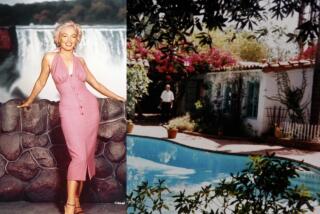Historical Ralph Bunche Home Awaits Funds for Restoration
- Share via
Although it has been declared a historical landmark, the boyhood home of Ralph J. Bunche, the Nobel Peace Prize winner from South Los Angeles, is boarded up and covered with graffiti, a victim of a funding delay at City Hall.
The modest white home on East 40th Place was purchased three years ago by a local nonprofit organization with plans to turn the building into a museum and tribute to nonviolence.
Bunche, the first African American to win the Nobel Peace Prize, drafted the historic U.N. Middle East armistice in 1949.
Mayor Richard Riordan’s Targeted Neighborhood Initiative, a community improvement program, has promised $100,000 to restore the Bunche home. But the money has been bottled up for two years, leaving the home at the mercy of trespassers and vandals.
The house has been boarded up to prevent further break-ins but the outside walls are marred with graffiti.
“It could be a permanent museum to what Dr. Bunche was all about,” said Anthony Scott, executive director of the Dunbar Economic Development Corp., the nonprofit group that plans to restore the home.
City officials say money for the Bunche house has been delayed while officials draft guidelines that allow the nonprofit group to use public funds. Most projects funded by the mayor’s initiative are managed by a city agency.
“It has taken much longer than anyone has anticipated,” said Herbert Marshall, a project manager for the city’s Community Redevelopment Agency. He said the city will probably release the money within three months.
The Dunbar group plans to restore the house to its original 1920s appearance and convert the front part of the house to a museum of Bunche’s life and his work. The group plans to use the back of the house for a conflict resolution program.
Black leaders say preservation of the Bunche home will keep alive the memory of an important African American.
“He was certainly an outstanding citizen not only of Los Angeles and South Los Angeles, but also of this nation,” said Geraldine R. Washington, president of the Los Angeles NAACP. “He deserves to be honored by all of us.”
Washington said she is appalled that Bunche’s house has become a neighborhood eyesore. “We should all be ashamed because he meant so much to this country.”
Bunche moved to South Los Angeles to live with his grandmother after his parents died in 1916. He graduated from Jefferson High School and attended UCLA, where he was a basketball and track star. The grandson of a former slave, Bunche earned a doctorate at Harvard University and went on to teach at Howard University, becoming chairman of the political science department.
During World War II, he worked for the Office of Strategic Services and then the State Department and the United Nations.
As a U.N. representative, Bunche worked in the Middle East during the Suez Crisis and the Six-Day War. He also spent time working in Lebanon, Cyprus, Yemen and the Congo.
Bunche is best known for his tireless work in negotiating and drafting the 1949 Israeli-Arab armistice, an effort that won him the Nobel Peace Prize in 1950.
In 1963, he was awarded the Presidential Medal of Freedom.
Bunche was also a civil rights activist, joining Martin Luther King Jr. in 1965 in a 50-mile march from Selma to Montgomery, Ala.
Bunche died in 1971 at age 67. Five years later, the city declared his home a cultural and historic landmark.
In 1992, a former gang member used Bunche’s 1949 armistice as a blueprint for a peace treaty between the warring Bloods and Crips gangs in South Los Angeles.
for bunche.1
More to Read
Sign up for Essential California
The most important California stories and recommendations in your inbox every morning.
You may occasionally receive promotional content from the Los Angeles Times.














